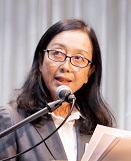A Great Undertaking by Umekichi Yoneyama
October 3, 2018
Ms. Yuki Shibazaki
Journalist
ˇˇ Umekichi Yoneyama was born in the 1st year of the Meiji Era (1868) and passed away in 1946, aged 78, the year after WWII ended. This year is the 150th anniversary of his birth and also Mr. Paul HarrisˇÇ, the founder of Rotary Club, who died in 1947.
Umekichi Yoneyama was born in the 1st year of the Meiji Era (1868) and passed away in 1946, aged 78, the year after WWII ended. This year is the 150th anniversary of his birth and also Mr. Paul HarrisˇÇ, the founder of Rotary Club, who died in 1947.
ˇˇMr. Yoneyama was born in Tokyo as the third son of the Wada family. His father was a samurai warrior and his mother was a daughter of a priest of the Mishima Grand Shrine. He was adopted into the Yoneyama family, a landowner of Nagaizumi, Shizuoka Prefecture. After studying at Tokyo Eiwa Gakko (currently Aoyama Gakuin) he went to study in the USA. He seemed to have encountered various problems as he was a privately financed student. At the World Exposition in Chicago he worked as a commentator of the Japanese Pavillion, ˇČPhoenix HallˇÉ, modelled after ˇČPhoenix HallˇÉ of Byodoin Temple in Kyoto. It seems to have influenced Frank Lloyd Wright, a renowned architect, who later designed the old Imperial Hotel.
ˇˇReturning to Japan, Mr. Yoneyama was closely associated with Kaishu Katsu, a leading figure of the Meiji Restoration. Mr. YoneyamaˇÇs first publication was ˇČCommodore PerryˇÉ, of which Kaishu Katsu had written the title with a brush.
ˇˇAfter that Mr. Yoneyama joined Mitsui Bank, currently Sumitomo Mitsui Bank, and entered the world of business. While he was a Branch Manager of the bank, he was blessed with five children and he was a doting father, saying ˇČThey are my family treasureˇÉ.
ˇˇAs a member of the GovernmentˇÇs economy and finance mission, he went to the USA again and met the first Japanese Rotarian, Kisouji Fukushima, in Dallas who was a President of a local subsidiary of Mitsui Corporation. By the effort of these two gentlemen, Tokyo RC was founded in 1920. To start with, members were selected on the basis of being bilingual with an international mindset.
ˇˇThen Mr. Yoneyama was struck by a great tragedy: his two sons died one after the other just before and after the Great Kanto Earthquake of 1923, which motivated him to assist young students. The earthquake was also a turning point for Japanese Rotary activities. Heartwarming assistance came from Rotary Clubs around the world to newborn Japanese RCs, which triggered a steady development of Japanese RC, as Rotarians were deeply impressed by the Rotary spirit. Thus, the Great Kanto Earthquake became a turning point for Japanese Rotary.
ˇˇAfter the earthquake the Mitsui Main Building was reconstructed. It was designated as an Important Cultural Property and is still used after 90 years. In the year of the Great Kanto Earthquake, the Trust Act was enacted and in the following year the first trust bank, Mitsui Trust Co. Ltd., currently Sumitomo Mitsui Trust Bank, was established, of which Mr. Yoneyama became President. He introduced the new management method he had learned in the USA. That is Executive Officer System of separating Board of Directors and management, which is now adopted by many listed companies. He believed that Trust Business is most suitable to realize Rotary spirit of ˇČSocial Contribution through OneˇÇs VocationˇÉ. He often mentioned ˇČOne Profits Most Who Serves BestˇÉ, another Rotary Slogan. He asked his employees to practice the spirit of service in the daily work and gave a name card holder engraved with ˇČKeep Your Name CleanˇÉ to every new employee. As a Chairman of Trust Companies Association of Japan, he contributed to the development of Japanese Trust Business.
ˇˇThe last enterprise of Mr. and Mrs. Yoneyama was an establishment of a kindergarten and an elementary school of Aoyama Gakuin School. Impressed by the educational philosophy of Mr. Yoshimune Abe, then President of Aoyama Gakuin and a member of Tokyo Ginza RC, Mr. Yoneyama devoted all his enthusiasm and assets for the primary education of Aoyama Gakuin. He became the 1st Principal of elementary school and his wife, Haruko, became a Head of kindergarten of Aoyama Gakuin. In a few yearsˇÇ time during WW¶, however, the school buildings were burnt down by an air raid together with YoneyamaˇÇs residence. After the war the elementary school was reconstructed and it celebrated its 80th anniversary last December. There is a Yoneyama Memorial Chapel in the campus and the bust of the 1st Principal greets the children at the gate every day.
ˇˇYoneyama Foundation which was initiated by Tokyo RC in accordance with the late Mr. YoneyamaˇÇs wishes developed into a joint project of all Rotarians across Japan. In 1967 the Yoneyama Memorial Scholarship Foundation was established, which celebrated its 50th anniversary last year. This is the largest scholarship project of private sector in Japan, and evaluated highly as a unique Rotary scholarship project of Japan.
ˇˇAfter the war, Mr. Yoneyama attended the first Parliament session as an Imperial nominee to the House of Peers in spite of his ill health. He passed away without witnessing the reinstatement of Japanese Rotary Club to RI.
ˇˇ2019 is the 50th anniversary of the foundation of Umekichi Yoneyama Memorial Hall and 2020 is the centennial anniversary of the foundation of Rotary Club in Japan.